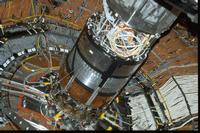 One of the two STIC calorimeters after it has been installed around the
beampipe in one of the end-caps of DELPHI. The white cables in the lower
right corner are fiberbundles for the Vetocounter.
One of the two STIC calorimeters after it has been installed around the
beampipe in one of the end-caps of DELPHI. The white cables in the lower
right corner are fiberbundles for the Vetocounter.
|
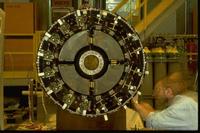 Front-view of a STIC calorimeter. In the center of the calorimeter is the
hole for the beampipe. Around the hole is a ring of electronics for the
LED system and around the outer edge is a ring of electronics for the Si
Strip shower maximum detector.
Front-view of a STIC calorimeter. In the center of the calorimeter is the
hole for the beampipe. Around the hole is a ring of electronics for the
LED system and around the outer edge is a ring of electronics for the Si
Strip shower maximum detector.
|
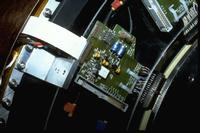 One of the 16 amplifier cards used to amplify the signals from the Si Strip
detectors. These cards sits on a ring-shaped printed circuit board together
with two so-called master-cards which are used for the final 8 to 1 multiplexing
of the Si strip signals from the amplifier cards before they are sent to
the Sirocco Flash ADCs in the countingroom.
One of the 16 amplifier cards used to amplify the signals from the Si Strip
detectors. These cards sits on a ring-shaped printed circuit board together
with two so-called master-cards which are used for the final 8 to 1 multiplexing
of the Si strip signals from the amplifier cards before they are sent to
the Sirocco Flash ADCs in the countingroom.
|
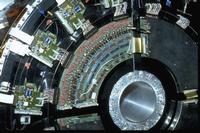 Close-up of the front showing the details of the LED and Si Strip electronics.
Close-up of the front showing the details of the LED and Si Strip electronics.
|
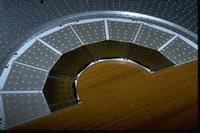 One of the two Silicon Strip detector layers showing the inner ring of
Si Strip detectors. A complete layer has also an outer ring.
One of the two Silicon Strip detector layers showing the inner ring of
Si Strip detectors. A complete layer has also an outer ring.
|
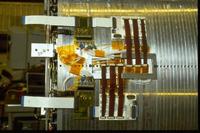 A side-view of STIC showing the kapton cables which takes the Si Strip
signals out of the calorimeter and two MX4 fan-in cards used for the first
120 to 1 multiplexing and for charge amplification.
A side-view of STIC showing the kapton cables which takes the Si Strip
signals out of the calorimeter and two MX4 fan-in cards used for the first
120 to 1 multiplexing and for charge amplification.
|
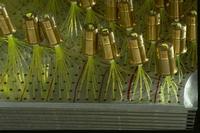 A close-up of the wavelength shifting fibers and the fiberholders which
are attached to tetrodes in the finished detector.
A close-up of the wavelength shifting fibers and the fiberholders which
are attached to tetrodes in the finished detector.
|
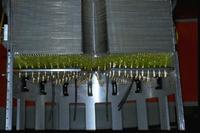 The inside of one calorimeter module (a calorimeter consists of two such
modules). The top half of the picture shows the sandwich structure of the
detector and the bottom half shows bundles of wavelength shifting fibers.
The inside of one calorimeter module (a calorimeter consists of two such
modules). The top half of the picture shows the sandwich structure of the
detector and the bottom half shows bundles of wavelength shifting fibers.
|
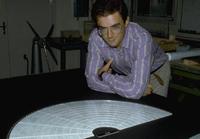 Tiziano Camporesi admiring a half-layer of scintillators. The complete
detectors consists of 47 lead-scintillator layers and two Al-Si strip layers.
Tiziano Camporesi admiring a half-layer of scintillators. The complete
detectors consists of 47 lead-scintillator layers and two Al-Si strip layers.
|
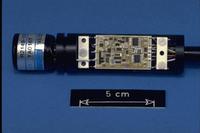 One of the Hamamatsu R2149 tetrodes used to read out the light together
with its preamplifier.
One of the Hamamatsu R2149 tetrodes used to read out the light together
with its preamplifier.
|
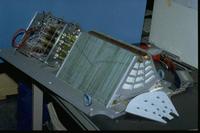 The STIC prototype detector which was tested in a testbeam in the West
Area before the construction of STIC.
The STIC prototype detector which was tested in a testbeam in the West
Area before the construction of STIC.
|
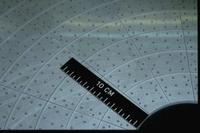 A close up of a scintillator layer showing the tower structure. Each calorimeter
has 160 projective towers. There are several holes for the fibers in each
scintillator tower tile and in addition two holes used to attach the tile
with a very high precision to the lead plate.
A close up of a scintillator layer showing the tower structure. Each calorimeter
has 160 projective towers. There are several holes for the fibers in each
scintillator tower tile and in addition two holes used to attach the tile
with a very high precision to the lead plate.
|
 One of the two STIC calorimeters after it has been installed around the
beampipe in one of the end-caps of DELPHI. The white cables in the lower
right corner are fiberbundles for the Vetocounter.
One of the two STIC calorimeters after it has been installed around the
beampipe in one of the end-caps of DELPHI. The white cables in the lower
right corner are fiberbundles for the Vetocounter.
 Front-view of a STIC calorimeter. In the center of the calorimeter is the
hole for the beampipe. Around the hole is a ring of electronics for the
LED system and around the outer edge is a ring of electronics for the Si
Strip shower maximum detector.
Front-view of a STIC calorimeter. In the center of the calorimeter is the
hole for the beampipe. Around the hole is a ring of electronics for the
LED system and around the outer edge is a ring of electronics for the Si
Strip shower maximum detector.
 One of the 16 amplifier cards used to amplify the signals from the Si Strip
detectors. These cards sits on a ring-shaped printed circuit board together
with two so-called master-cards which are used for the final 8 to 1 multiplexing
of the Si strip signals from the amplifier cards before they are sent to
the Sirocco Flash ADCs in the countingroom.
One of the 16 amplifier cards used to amplify the signals from the Si Strip
detectors. These cards sits on a ring-shaped printed circuit board together
with two so-called master-cards which are used for the final 8 to 1 multiplexing
of the Si strip signals from the amplifier cards before they are sent to
the Sirocco Flash ADCs in the countingroom.
 Close-up of the front showing the details of the LED and Si Strip electronics.
Close-up of the front showing the details of the LED and Si Strip electronics.
 One of the two Silicon Strip detector layers showing the inner ring of
Si Strip detectors. A complete layer has also an outer ring.
One of the two Silicon Strip detector layers showing the inner ring of
Si Strip detectors. A complete layer has also an outer ring.
 A side-view of STIC showing the kapton cables which takes the Si Strip
signals out of the calorimeter and two MX4 fan-in cards used for the first
120 to 1 multiplexing and for charge amplification.
A side-view of STIC showing the kapton cables which takes the Si Strip
signals out of the calorimeter and two MX4 fan-in cards used for the first
120 to 1 multiplexing and for charge amplification.
 A close-up of the wavelength shifting fibers and the fiberholders which
are attached to tetrodes in the finished detector.
A close-up of the wavelength shifting fibers and the fiberholders which
are attached to tetrodes in the finished detector.
 The inside of one calorimeter module (a calorimeter consists of two such
modules). The top half of the picture shows the sandwich structure of the
detector and the bottom half shows bundles of wavelength shifting fibers.
The inside of one calorimeter module (a calorimeter consists of two such
modules). The top half of the picture shows the sandwich structure of the
detector and the bottom half shows bundles of wavelength shifting fibers.
 Tiziano Camporesi admiring a half-layer of scintillators. The complete
detectors consists of 47 lead-scintillator layers and two Al-Si strip layers.
Tiziano Camporesi admiring a half-layer of scintillators. The complete
detectors consists of 47 lead-scintillator layers and two Al-Si strip layers.
 One of the Hamamatsu R2149 tetrodes used to read out the light together
with its preamplifier.
One of the Hamamatsu R2149 tetrodes used to read out the light together
with its preamplifier.
 The STIC prototype detector which was tested in a testbeam in the West
Area before the construction of STIC.
The STIC prototype detector which was tested in a testbeam in the West
Area before the construction of STIC.
 A close up of a scintillator layer showing the tower structure. Each calorimeter
has 160 projective towers. There are several holes for the fibers in each
scintillator tower tile and in addition two holes used to attach the tile
with a very high precision to the lead plate.
A close up of a scintillator layer showing the tower structure. Each calorimeter
has 160 projective towers. There are several holes for the fibers in each
scintillator tower tile and in addition two holes used to attach the tile
with a very high precision to the lead plate.